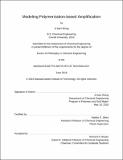| dc.contributor.advisor | Hadley D. Sikes. | en_US |
| dc.contributor.author | Wong, Ji Sam | en_US |
| dc.contributor.other | Massachusetts Institute of Technology. Department of Chemical Engineering. | en_US |
| dc.date.accessioned | 2016-09-13T18:07:22Z | |
| dc.date.available | 2016-09-13T18:07:22Z | |
| dc.date.copyright | 2016 | en_US |
| dc.date.issued | 2016 | en_US |
| dc.identifier.uri | http://hdl.handle.net/1721.1/104123 | |
| dc.description | Thesis: Ph. D., Massachusetts Institute of Technology, Department of Chemical Engineering, 2016. | en_US |
| dc.description | This electronic version was submitted by the student author. The certified thesis is available in the Institute Archives and Special Collections. | en_US |
| dc.description | Cataloged from student-submitted PDF version of thesis. | en_US |
| dc.description | Includes bibliographical references (pages 117-120). | en_US |
| dc.description.abstract | Eosin, a photoreducible xanthene derivative, acts as a Type II photoinitiator of free radical polymerizations when used in combination with alcohols or amines as co-initiators. Previous work utilizing eosin in polymerizations focused on high concentrations of initiators but it has recently been gaining use in bio-applications at lower concentrations due to its ability to initiate polymerizations when illuminated by harmless visible light even in the presence of orders-of-magnitude larger amounts of dissolved oxygen which acts as an inhibitor. We investigated the mechanism behind eosin's role in the polymerization process and its ability to initiate polymerization at concentrations lower than that of oxygen. A series of model simulation studies that systematically examined the effects of including additional elementary reactions based on proposed reactions in published literature into the classical free radical polymerization scheme without fitting any unknown parameters to experimental results were performed and analyzed. The first study examined the effect on having an eosin regeneration reaction between the reduced eosin radical which is formed during the photogeneration of free radicals, and the peroxy radical formed by inhibiting reactions of propagating radicals with oxygen. This reaction results in an unreactive hydroperoxy species and the regeneration of ground state eosin which can then produce even more radicals that undergo propagation. The simulation results indicated that the additional eosin regeneration reaction did explain eosin's ability to initiate polymerization at lower concentrations than oxygen, but the best predicted times required for the formation of polymer was larger than experiments by an order of magnitude, suggesting that the reaction scheme was incomplete. We subsequently incorporated an amine chain peroxidation reaction into the overall reaction scheme and determined the effects of such a change. The amine chain peroxidation reaction involves the peroxy radical extracting a hydrogen atom from the tertiary amines present in the reaction mixture, forming an unreactive hydroperoxide species and an amino-radical that can further undergo propagation. The addition of this reaction greatly increased the rate of oxygen consumption and reduced the predicted polymerization times to an order of magnitude lower than experiments. In addition to purely kinetic studies on the overall reaction scheme, a one-dimensional reaction-diffusion model was also created to understand the effects of having a continuously diffusing oxygen flux on the overall polymerization process. The time course of polymerization and spatial variations when using the various reaction schemes were analyzed and contrasted. The models predicted the formation of a reaction front which forms at the onset of polymerization and slowly moves towards the closed surface, tracking the diffusion of oxygen back into the reaction system. A surface region of higher eosin concentrations was also simulated to model the effects of binding events occurring in polymerization-based amplification (PBA). The addition of a small amount of eosin on the surface resulted in slightly faster predicted polymerization times close to the surface, similar to experimental observations where a surface polymer is first formed before the whole solution polymerizes where binding events have occurred. | en_US |
| dc.description.statementofresponsibility | by Ji Sam Wong. | en_US |
| dc.format.extent | 120 pages | en_US |
| dc.language.iso | eng | en_US |
| dc.publisher | Massachusetts Institute of Technology | en_US |
| dc.rights | M.I.T. theses are protected by copyright. They may be viewed from this source for any purpose, but reproduction or distribution in any format is prohibited without written permission. See provided URL for inquiries about permission. | en_US |
| dc.rights.uri | http://dspace.mit.edu/handle/1721.1/7582 | en_US |
| dc.subject | Chemical Engineering. | en_US |
| dc.title | Modeling polymerization-based amplification | en_US |
| dc.type | Thesis | en_US |
| dc.description.degree | Ph. D. | en_US |
| dc.contributor.department | Massachusetts Institute of Technology. Department of Chemical Engineering | |
| dc.identifier.oclc | 958140510 | en_US |
